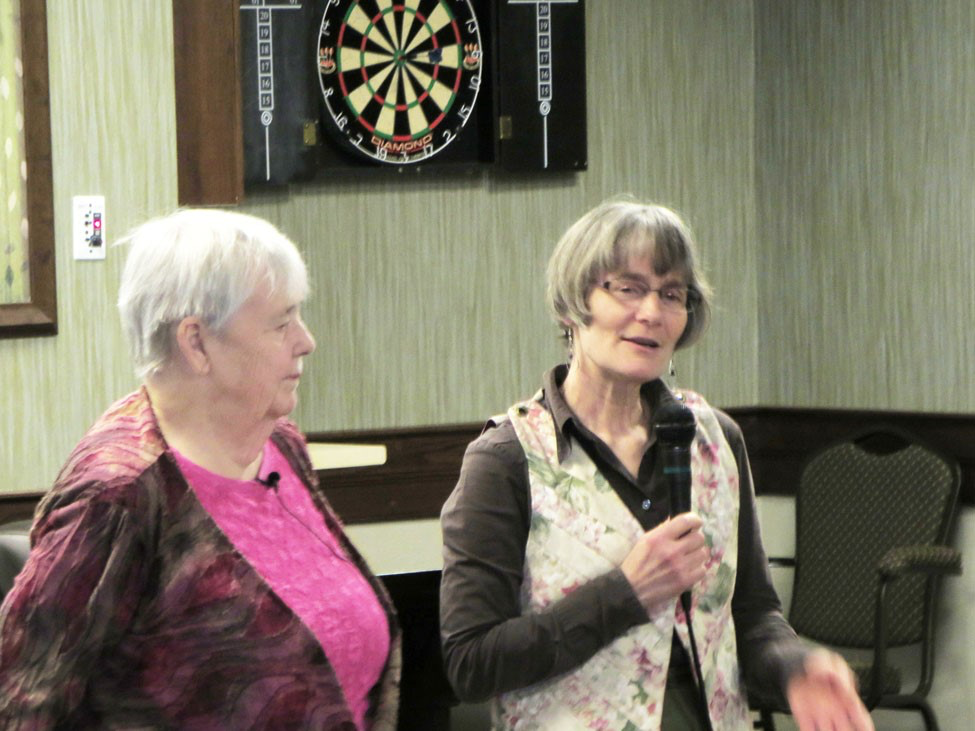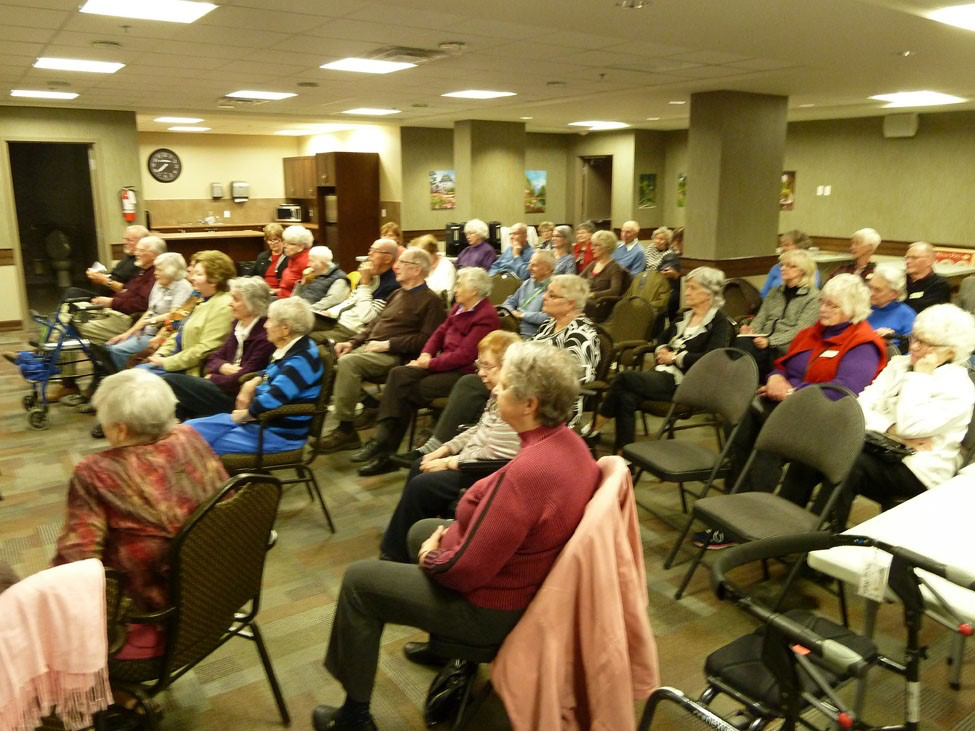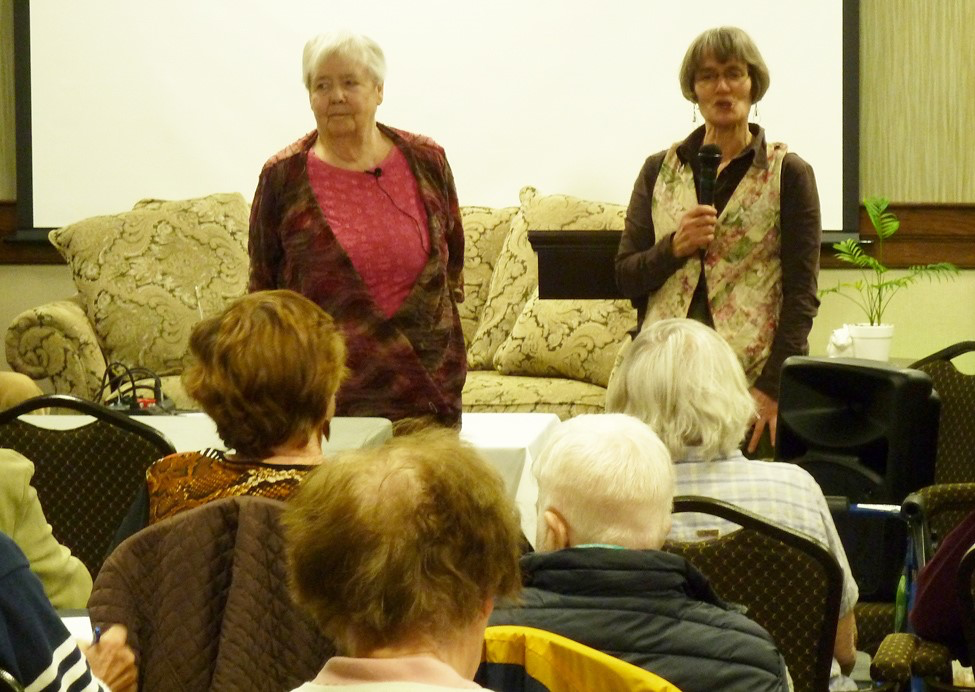The Famous Five Women
Presentation by Ruth Stewart Verger and Donna Verger. Article by Maureen McPhee, Photos by Maureen McPhee and Owen Cooke. April, 2017.
Donna Stewart and Ruth Stewart-Verger approached the April presentation not as the making of a speech, but rather as storytelling. Both have extensive experience in telling stories from Canada’s history.
They began the evening by asking members of the audience to close their eyes and travel back to the nineteenth and early twentieth centuries, a world far apart where women wore long dresses and the work was hard.
In 1868, three babies were born who would become associated in later life. They were Irene Marryat in London England, Louise Crummy in Frankville Ontario, and Emily Ferguson in Cookstown Ontario. Louise was born into a wealthy British family, whereas Louise was a member of a strict Methodist farming family. Emily was influenced by her father who believed that his daughter should be tutored just like her brothers and allowed to sit in the parlour to listen to the men talk politics.
The other two women who were later among the Famous Five were Henrietta Muir, born in Montreal in1849, and Nellie Mooney, born in Chatsworth Ontario in 1873. Henrietta was an accomplished artist and when she sold her first painting, she established a reading room for poor, working women. This was a forerunner to the YWCA. Nellie moved to Manitoba with her family searching for a better farm and life.
All of the women married and moved west. Louise Crummy McKinney settled in Alberta where she was very active in the temperance movement. Henrietta Muir Edward’s husband did work in relation to Indian reserves and Henrietta wrote and read widely. In addition she worked with Lady Aberdeen to found the Victorian Order of Nurses (VON). She helped to establish YWCAs across the country. Emily Murphy married an Edmonton preacher and became the perfect housewife, a pillar of her church and a member of many organizations. Irene Marryat Parlby shocked London society by travelling to North America, where she met her husband Walter and settled on an Alberta homestead. Nellie Mooney McClung married and lived in Winnipeg, subsequently moving to Alberta.
Emily Murphy liked to ride a pony around her area and introduce herself to other farm wives. One such day she met a woman whose husband had sold their farm, She thus learned that the property was owned entirely by the husband. Emily wrote to Henrietta Edwards saying that this was not right and something had to be done about the law. Emily went on to research the issue, write papers and talk to the holders of power. Working with Louise McKinney, she helped to establish the Dower Act which recognized the property rights of married women.
Over the years, these five women became involved in each other’s activities. Emily, for example, wrote about Henrietta’s work in founding the VON. Emily also wrote about hospitals and health care. When the Hospital Board for Edmonton did a brief hospital tour and then adjourned for refreshments, Emily continued to tour on her own and wrote a report for the newspapers telling of waste, dirty conditions and patient mistreatment.
Nellie, who was still in Winnipeg at the time, wrote to Emily commending her on the article and stressing the importance of fighting for good working conditions for women. Nellie invited Premier Roblin to tour a garment factory in Winnipeg. The Premier cut the tour short when faced with the smell of an overflowing toilet. When Nellie asked him on the journey back if a woman would be hired to investigate such working conditions and propose legislation, the Premier said no, as it would be too costly for employers.
The Famous Five cared deeply about the vote for women and organized rallies, marches and events, such as pink teas. Women would gather wearing pink dresses or bows, eat pink sandwiches, drink tea and talk politics. Emily and Henrietta asked to speak to the Alberta legislature about the vote, but when they arrived there, Louise and Irene also walked in with them, followed closely by many more women who filled the legislature.
The women gave speeches while the men heckled, Louise talking about politics being housekeeping on a national scale. Three years later, in 1916, women in Alberta received the right to vote. Emily and Nellie celebrated by walking down the main street in Edmonton, buying new hats and having their pictures taken.
Louise ran for the Alberta legislature and was elected in 1917, becoming the first woman in the Commonwealth to hold a legislative seat. Both Irene and Nellie were elected to the Alberta legislature in 1921, though they represented different parties. Many pieces of legislation were influenced by their work. Irene went on to become a Cabinet minister.
Women now had power and at a meeting of the National Council of Women, it was decided that something needed to be done to fill gaps in legislation affecting women. Henrietta compiled a list of provincial laws affecting women and children and was soon asked to also look at federal laws. Her work was soon on the desk of every lawyer.
Emily wanted to become a Senator; however, section 24 of the British North America Act spoke of persons of good standing being invited to serve, and women were not viewed as being persons. Irene determined that with five signatures, it would be possible to request that a federal law be passed allowing women to be appointed to the Senate. She wrote to her four friends seeking their support and they all agreed to sign such a letter. They met for a tea party on Emily’s veranda where they worked on a draft letter that she had prepared. The letter was sent, but the answer was a clear no.
The five friends then decided that an appeal should be made to the Supreme Court of Canada. They hired a lawyer and after several months work, they learned that the Department of Justice had changed their question to the court to: “Does the word persons apply to female persons.” Once again, the answer was no, a woman is not a person with rights or privileges.
The next step was an appeal to the Judicial Committee of the Privy Council of Great Britain. Their lawyer took the case to London. Emily had wanted to go but it was decided that they should all stay home. Nevertheless, Emily wrote to the lawyer every day with suggestions. On October 18, 1929 at midnight, Emily received a phone call in which the lawyer said: “Mrs. Murphy, you are a person.” She then called the others with the news.
It was an exciting time, as women were not considered persons anywhere else, including England. At a press conference, Emily Murphy said women must now take responsibility and step forward to become one half of the members of legislatures. Nellie said that she had always wanted to be a person and now she knew for sure that she was. Henrietta noted that everyone must remember the men who helped to move the issue forward and the fact that the Government of Canada had paid for both of the appeals.
Louise and Henrietta were persons for two years, as they both passed away in 1931. Emily was a person for four years until she died of a heart attack in 1933. Nellie was active for 22 years, working on issues such as pensions, Medicare, education and the formation of the United Church of Canada. Irene was a person for 36 years, until she passed away in 1965 at the age of 96. She had retired from the legislature in 1935, moving back to the farm. She served as Canada’s representative to the League of Nations.
A Senator was once asked why none of the Famous Five were appointed to the Senate. He responded that the only one who had wanted to be appointed was Emily Murphy, but “she would have made too much trouble."



